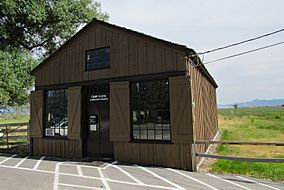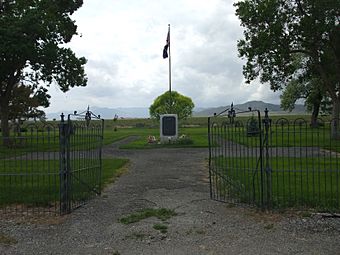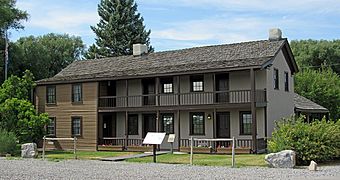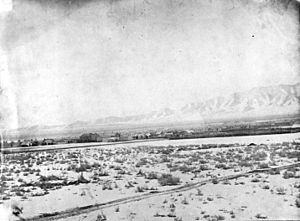Camp Floyd State Park Museum facts for kids
Quick facts for kids Camp Floyd State Park Museum |
|
|---|---|
| Camp Floyd / Stagecoach Inn State Park and Museum | |

Camp Floyd Commissary and Museum, June 2015
|
|
| Location | Fairfield, Utah, United States |
| Elevation | 4,877 feet (1,487 m) |
| Established | 1964 |
| Named for | Camp Floyd |
| Visitors | 18,303 (in 2022) |
| Governing body | Utah Division of Parks and Recreation |
| Website | |
|
Camp Floyd Site
|
|

Camp Floyd Cemetery, June 2009
|
|
| Location | Fairfield, Utah United States |
| Area | 40 acres (16.2 ha) |
| NRHP reference No. | 74001939 |
| Added to NRHP | November 11, 1974 |
|
Stagecoach Inn
|
|

Stagecoach Inn, June 2015
|
|
| Location | 69 West Main Street Fairfield, Utah United States |
| Area | 1.4 acres (0.6 ha) |
| NRHP reference No. | 71000857 |
| Added to NRHP | May 14, 1971 |
The Camp Floyd State Park Museum is a cool place to visit in Fairfield, Utah. It used to be called the Camp Floyd / Stagecoach Inn State Park and Museum. This park helps us remember an important time in Utah's history.
The park includes a small part of the old Camp Floyd army base. It also features the historic Stagecoach Inn and the Fairfield District School. These sites show how Utah was settled and how it dealt with the U.S. government long ago.
Contents
What You'll See at Camp Floyd Park
The park's main office is at the Stagecoach Inn. All parts of the park are close by. You can explore Camp Floyd, which includes a military cemetery. You can also visit the Fairfield District School and the Stagecoach Inn. Each of these places is listed as a historic site on its own.
The park is open Monday through Saturday from 9:00 a.m. to 5:00 p.m. It's open year-round. During the summer, from Memorial Day to Labor Day, it's also open on Sundays. The park is closed on Thanksgiving, Christmas, and New Year's Day.
A Look Back at the Park's History
The Carson family gave the Stagecoach Inn to the state of Utah in 1958. They wanted the state to fix it up and turn it into a museum. The state also got the old commissary building and the army cemetery.
By the 1950s, the commissary building was mostly ruins. People had taken parts of it, and the roof was gone. The cemetery was fixed up and officially opened in 1960. The inn and commissary were also restored by the summer of 1960. The park officially opened to the public on May 16, 1964.
Camp Floyd: An Army Base in Utah
Camp Floyd was built in July 1858 by the U.S. Army. It was led by General Albert Sidney Johnston. The camp was named after John B. Floyd, who was the Secretary of War at the time.
More than 3,500 soldiers and civilians lived at Camp Floyd. This was the largest group of soldiers in the United States back then. President James Buchanan sent them to Utah. He thought there might be a rebellion by the Mormons, which was called the Utah War.
The army marched all the way from Kansas to Wyoming in 1857. They spent the winter there. In June 1858, they arrived in Utah. They settled in the Cedar Valley, near Fairfield. By November 1858, they had built 400 buildings. These included barracks, officers' homes, and warehouses.
Many civilians followed the army, and Fairfield grew quickly. Its population reached 7,000, almost half the size of Salt Lake City. The rebellion never happened. So, the army mostly did routine jobs. They protected stagecoach and Pony Express routes. They also helped prevent conflicts with Native Americans and mapped the area.
Supplying such a large army base was very expensive. It was about 1,100 miles (1,800 km) from their main supply point. A company called Russell, Majors and Waddell brought in tons of supplies. They needed 3,500 wagons, 40,000 oxen, and 1,000 mules. This same company later started the famous Pony Express. Fairfield even had a Pony Express station!
In 1860, Secretary of War Floyd resigned. Camp Floyd was then renamed Fort Crittenden. It was named after Senator John J. Crittenden, who worked to keep Kentucky in the Union. The camp was closed in July 1861. The soldiers were called back east to fight in the American Civil War.
Most of the buildings and equipment were sold or destroyed. Today, only the military cemetery and one commissary building remain. Just two months after the army left, only 18 families still lived in Fairfield.
A 40-acre (16 ha) area of the Camp Floyd site was added to the National Register of Historic Places in 1974. At that time, only the cemetery was left from the original camp.
Fairfield District School: A Historic Classroom
The Fairfield District School is an old schoolhouse built in 1898. It is located at 59 North Church Street. This school is also listed on the National Register of Historic Places.
Stagecoach Inn: A Stop on the Trail
The Stagecoach Inn was also known as the John Carson House. It served as a hotel for travelers. It was an important stop on the overland stagecoach route. This was before the transcontinental railroad opened in 1869. It was the first stop south of Salt Lake City. From 1860 to 1861, the inn was also a stop for the Pony Express. The area around the inn is known as the Stage Coach Inn State Historical Site. It was added to the National Register of Historic Places in 1971.
See also




